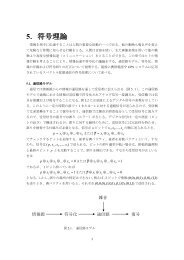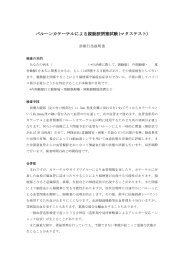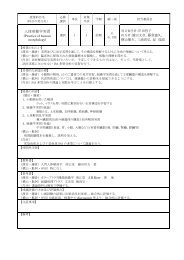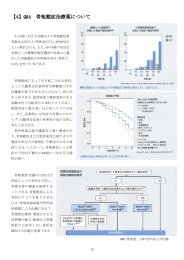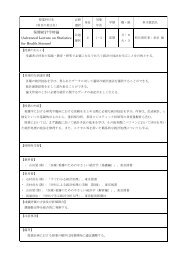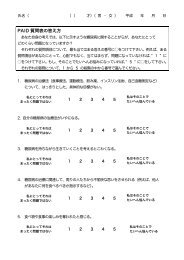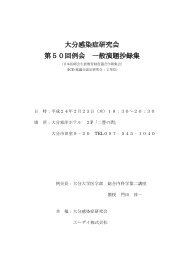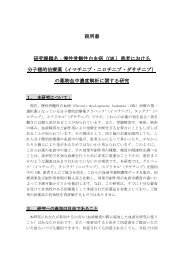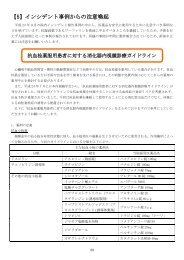fibulins: a versatile family of extracellular matrix proteins
fibulins: a versatile family of extracellular matrix proteins
fibulins: a versatile family of extracellular matrix proteins
You also want an ePaper? Increase the reach of your titles
YUMPU automatically turns print PDFs into web optimized ePapers that Google loves.
REVIEWSMARFAN SYNDROMEA heritable connective tissuedisease that affects several organsystems, including the skeleton,eyes, lungs, heart and bloodvessels. The disease is caused bydominant mutations in thefibrillin-1 gene.(which results in an S227P substitution; where S is serineand P is proline) in FBLN5 in a <strong>family</strong> that wasaffected by a severe form <strong>of</strong> cutis laxa 79 . S227 is locatedbetween Cys3 and Cys4 in cbEGF3 <strong>of</strong> fibulin-5. Thisamino-acid substitution is probably the cause <strong>of</strong> cutislaxa in this <strong>family</strong>, as the corresponding position inmost <strong>of</strong> the cbEGF-like modules in fibrillin-1 is occupiedby a serine, and an analogous mutation in fibrillin-1results in MARFAN SYNDROME. Although the heterozygouscarriers <strong>of</strong> the missense mutation in this<strong>family</strong> are not affected, cutis laxa can result from a heterozygousmutation in fibulin-5. A patient with amilder phenotype <strong>of</strong> cutis laxa carries a heterozygoustandem gene duplication <strong>of</strong> 22 kb in FBLN5, whichresults in the duplication <strong>of</strong> exons 5–8 that encodefour cbEGF-like domains 80 . The mutant fibulin-5 proteinwith four extra cbEGF-like domains is synthesizedand secreted by the patient’s fibroblasts inamounts that are somewhat greater than for a normalcounterpart, so the mutation probably exerts adominant-negative effect.Conclusions and perspectivesThe <strong>fibulins</strong> represent a newly characterized <strong>family</strong> <strong>of</strong>calcium-binding ECM <strong>proteins</strong> and five is<strong>of</strong>orms haveso far been characterized from mammalian species. The<strong>fibulins</strong> do not form large homotypic aggregates, in contrastto many other ECM <strong>proteins</strong>, but they have theability to join other supramolecular structures as diverseas basement-membrane networks, elastic fibres, severaltypes <strong>of</strong> micr<strong>of</strong>ibrils and proteoglycan aggregates. Theirinclusion, in part, stabilizes these structures, but alsoextends their repertoire <strong>of</strong> biological functions. The latterpoint is highlighted by genetic studies <strong>of</strong> inheriteddiseases and <strong>of</strong> transgenic animals. Some <strong>fibulins</strong> alsohave the ability to interact with cells, in part, throughinteractions with RGD-dependent integrins. There isalso increasing evidence that <strong>fibulins</strong> control the growth<strong>of</strong> normal and malignant cells. These studies are still in apreliminary stage and, in the future, a comprehensivecharacterization <strong>of</strong> the receptors and signal-transductionpathways involved will be required in order to evaluatetheir biological significance.1. Argraves, W. S., Dickerson, K., Burgess, W. H. & Ruoslahti, E.Fibulin, a novel protein that interacts with the fibronectinreceptor β subunit cytoplasmic domain. Cell 58, 623–629(1989).2. Argraves, W. S., Tran, H., Burgess, W. H. & Dickerson, K.Fibulin is an <strong>extracellular</strong> <strong>matrix</strong> and plasma glycoproteinwith repeated domain structure. J. Cell Biol. 111,3155–3164 (1990).Fibulin-1 is identified and is found to be a new class <strong>of</strong>ECM protein.3. Kluge, M., Mann, K., Dziadek, M. & Timpl, R.Characterization <strong>of</strong> a novel calcium-binding 90-kDaglycoprotein (BM-90) shared by basement membranes andserum. Eur. J. Biochem. 193, 651–659 (1990).4. Pan, T.-C. et al. Sequence <strong>of</strong> <strong>extracellular</strong> mouse proteinBM-90/fibulin and its calcium-dependent binding to otherbasement membrane ligands. Eur. J. Biochem. 215,733–740 (1993).5. Pan, T.-C. et al. Structure and expression <strong>of</strong> fibulin-2, a novel<strong>extracellular</strong> <strong>matrix</strong> protein with multiple EGF-like repeatsand consensus motifs for calcium-binding. J. Cell Biol. 123,1269–1277 (1993).The first evidence that there is a fibulin protein <strong>family</strong>that contains different fibulin is<strong>of</strong>orms.6. Zhang, R.-Z. et al. Fibulin-2 (FBLN2): human cDNAsequence, mRNA expression and mapping <strong>of</strong> the gene onhuman and mouse chromosomes. Genomics 22, 425–430(1994).7. Sasaki, T., Göhring, W., Pan, T.-C., Chu, M.-L. & Timpl, R.Binding <strong>of</strong> mouse and human fibulin-2 to <strong>extracellular</strong> <strong>matrix</strong>ligands. J. Mol. Biol. 254, 892–899 (1995).8. Sasaki, T. et al. Dimer model for the micr<strong>of</strong>ibrillar proteinfibulin-2 and identification <strong>of</strong> the connecting disulfide bridge.EMBO J. 16, 3035–3043 (1997).The first extensive model <strong>of</strong> the fibulin-2 structure.9. Tran, H., Mattei, M., Godyna, S. & Argraves, W. S. HumanFibulin-1D: molecular cloning, expression and similarity withS1-5 protein, a new member <strong>of</strong> the fibulin-1 gene <strong>family</strong>.Matrix Biol. 15, 479–493 (1997).10. Giltay, R., Timpl, R. & Kostka, G. Sequence, recombinantexpression and tissue localization <strong>of</strong> two novel <strong>extracellular</strong><strong>matrix</strong> <strong>proteins</strong>, fibulin-3 and fibulin-4. Matrix Biol. 18,469–480 (1999).11. Zhang, H.-Y., Lardelli, M. & Ekblom, P. Sequence <strong>of</strong> zebrafishfibulin-1 and its expression in developing heart and otherembryonic organs. Dev. Genes Evol. 207, 340–351 (1997).12. Barth, J. L., Argraves, K. M., Roark, E. F., Little, C. D. &Argraves, W. S. Identification <strong>of</strong> chicken andC. elegans fibulin-1 homologs and characterization<strong>of</strong> the C. elegans fibulin-1 gene. Matrix Biol. 17, 635–646(1998).13. Huber, R., Scholze, H., Paques, E. P. & Deisenh<strong>of</strong>er, J.Crystal structure analysis and molecular model <strong>of</strong> humanC3a anaphylatoxin. Hoppe-Seyler’s Z. Physiol. Chem. 361,1389–1399 (1989).14. Lecka-Czernik, B., Lumpkin, C. K. & Goldstein, S.An overexpressed gene transcript in senescent andquiescent human fibroblasts encoding a novel protein in theepidermal growth factor-like repeat <strong>family</strong> stimulates DNAsynthesis. Mol. Cell. Biol. 15, 120–129 (1995).15. Gallagher, W. M. et al. Human fibulin-4: analysis<strong>of</strong> its biosynthetic processing and mRNA expression innormal and tumour tissues. FEBS Lett. 489, 59–66(2001).16. Maurer, P. & Hohenester, E. Structural and functionalaspects <strong>of</strong> calcium-binding in <strong>extracellular</strong> <strong>matrix</strong> <strong>proteins</strong>.Matrix Biol. 15, 569–580 (1997).17. Downing, A. K. et al. Solution structure <strong>of</strong> a pair <strong>of</strong> calciumbindingepidermal growth factor-like domains: implicationsfor the Marfan syndrome and other genetic disorders. Cell85, 597–605 (1996).This paper explains how the structure <strong>of</strong> cbEGF-likemodules is stabilized by calcium ligation.18. Sasaki, T., Mann, K., Murphy, G., Chu, M.-L. & Timpl, R.Different susceptibilities <strong>of</strong> fibulin-1 and fibulin-2 to cleavageby <strong>matrix</strong> metalloproteinases and other tissue proteases.Eur. J. Biochem. 240, 427–434 (1996).19. Sasaki, T. et al. Structural characterization <strong>of</strong> two variants <strong>of</strong>fibulin-1 that differ in nidogen affinity. J. Mol. Biol. 245,241–250 (1995).20. Roark, E. F. et al. The association <strong>of</strong> human fibulin-1with elastic fibers: an immunohistological, ultrastructural,and RNA study. J. Histochem. Cytochem. 43, 401–411(1995).21. Stone, E. M. et al. A single EFEMP1 mutationassociated with both Malattia Leventinese and Doynehoneycomb retinal dystrophy. Nature Genet. 22, 199–202(1999).22. Nakamura, T. et al. Fibulin-5/DANCE is essential forelastogenesis in vivo. Nature 415, 171–175 (2002).23. Yanagisawa, H. et al. Fibulin-5 is an elastin-binding proteinessential for elastic fibre development in vivo. Nature 415,168–171 (2002).This work describes, together with reference 22, therole <strong>of</strong> fibulin-5 in stabilizing elastic fibres.24. Spence, S. G., Argraves, W. S., Walters, L., Hungerford, J. E.& Little, C. Fibulin is localized at sites <strong>of</strong>epithelial–mesenchymal transitions in the early avianembryo. Dev. Biol. 151, 473–484 (1992).25. Zhang, H.-Y., Timpl, R., Sasaki, T., Chu, M.-L. & Ekblom, P.Fibulin-1 and fibulin-2 expression during organogenesis inthe developing mouse embryo. Dev. Dyn. 205, 348–364(1996).26. Miosge, N. et al. The <strong>extracellular</strong> <strong>matrix</strong> <strong>proteins</strong> fibulin-1and fibulin-2 in the early human embryo. Histochem. J. 28,109–116 (1996).27. Hungerford, J. E., Owens, G. K., Argraves, W. S. & Little, C. D.Development <strong>of</strong> aortic vessel wall as defined by vascularsmooth muscle and <strong>extracellular</strong> <strong>matrix</strong> markers. Dev. Biol.178, 375–392 (1996).28. Bouchey, D., Argraves, W. S. & Little, C. D. Fibulin-1,vitronectin expression during avian cardiac valveand septa development. Anat. Rec. 244, 540–551(1996).29. Zhang, H.-Y., Kluge, M., Timpl, R., Chu, M.-L. & Ekblom, P.The <strong>extracellular</strong> <strong>matrix</strong> glyco<strong>proteins</strong> BM-90 and tenascinare expressed in the mesenchyme at sites <strong>of</strong>endothelial–mesenchymal conversion in the embryonicmouse heart. Differentiation 52, 211–220 (1993).30. Zhang, H.-Y. et al. Extracellular <strong>matrix</strong> protein fibulin-2 isexpressed in the embryonic endocardial cushion tissue andis a prominent component <strong>of</strong> valves in adult heart. Dev. Biol.167,18–26 (1995).31. Tsuda, T., Wang, H., Timpl, R. & Chu, M.-L. Fibulin-2expression marks transformed mesenchymal cells indeveloping cardiac valves, aortic arch vessels and coronaryvessels. Dev. Dyn. 222, 89–100 (2001).32. Miosge, N., Sasaki, T., Chu, M.-L., Herken, R. & Timpl, R.Ultrastructural localization <strong>of</strong> micr<strong>of</strong>ibrillar fibulin-1 andfibulin-2 during heart development indicates a switch inmolecular associations. Cell. Mol. Life Sci. 54, 606–613(1997).33. Gallagher, W. M. et al. MBP1: a novel mutant p53-specificprotein partner with oncogenic properties. Oncogene 18,3608–3616 (1999).34. Kowal, R. C., Richardson, J. A., Miano, J. M. & Olsen, E. N.EVEC. A novel epidermal growth factor-like repeatcontaining protein upregulated in embryonic and injuredadult vasulature. Circ. Res. 84, 1166–1176 (1999).35. Ohsawa, I., Takamura, C. & Kohsaka, S. Fibulin-1 binds theamino-terminal head <strong>of</strong> β-amyloid precursor protein.J. Neurochem. 76, 1411–1420 (2001).36. Reinhardt, D. P. et al. Fibrillin-1 and fibulin-2 interact and arecolocalized in some tissues. J. Biol. Chem. 271,19489–19496 (1996).37. Sasaki, T. et al. Tropoelastin binding to <strong>fibulins</strong>, nidogen-2and other <strong>extracellular</strong> <strong>matrix</strong> <strong>proteins</strong>. FEBS Lett. 460,280–284 (1999).38. Sasaki, T., Wiedemann, H., Matzner, M., Chu, M.-L. & Timpl, R.Expression <strong>of</strong> fibulin-2 by fibroblasts and deposition withfibronectin into a fibrillar <strong>matrix</strong>. J. Cell Sci. 109, 2895–2904(1996).39. Loveland, K. et al. Developmental changes in the basementmembrane <strong>of</strong> the normal and hypothyroid postnatal rattestis: segmental localization <strong>of</strong> fibulin-2 and fibronectin.Biol. Reprod. 58, 1123–1130 (1998).40. Raghunath, M. et al. Confocal laser scanning analysis <strong>of</strong> theassociation <strong>of</strong> fibulin-2 with fibrillin-1 and fibronectin definedifferent stages <strong>of</strong> skin regeneration. J. Invest. Dermatol.112, 97–101 (1999).41. Fässler, R., Sasaki, T., Timpl, R., Chu, M.-L. & Werner, S.Differential regulation <strong>of</strong> fibulin, tenascin and nidogenexpression during wound healing <strong>of</strong> normal andglucocorticoid-treated mice. Exp. Cell Res. 222, 111–116(1996).488 | JUNE 2003 | VOLUME 4 www.nature.com/reviews/molcellbio© 2003 Nature PublishingGroup



